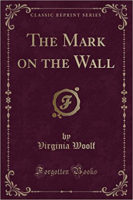Life in Lockdown: Re-Reading Woolf’s The Mark on the Wall
The Mark on the Wall is a brief tale in which Virginia Woolf describes a winter evening at home in the English countryside during WWI. She, like her fellow Britons, are under lockdown because of the war. Frankly, she has nothing but time on her hands, and she is so lonely that all she has to do with her time is gaze at a mark upon a wall.
The curious mark is the platform which allows her to ponder, not only the mark, but her life, her surroundings, and that pesky mark she cannot be bothered to walk across the room to identify. Could it be a nail? Perhaps a bit of gravy? She doesn’t know. So, she allows her mind to fly off in a thousand different meditations on life and death, on what it all means, on her place in the scheme of it all.
Woolf wrote this story in 1917 while the world was falling apart around her. She endured nightly air-raids, rockets blaring, shots fired across the channel. And, so, she used her writing as a way to escape it all.
The contemplation of a mark upon a wall seemed absurd to me when I read it years ago. But, now, having been a shut-in for these many weeks due to Covid-19, I find myself (like Woolf did) gazing at simple things around the house—toothpaste tubes, detergent boxes, and soup cans—and then my mind goes flying away. Life feels so foreign when shut indoors.
Woolf writes that life to her at that time felt like “being blown through the Tube at fifty miles an hour—landing at the other end without a single hair pin in one’s hair!”
That is exactly how I feel right now, too, that life is all of a sudden a bizarre affair in which we are utterly out of control, “with one’s hair flying back like the tail of a race horse.” And, heaven knows where on earth we will land.
The Mark on the Wall by Virginia Woolf. 1917.
Reviewer bio: M.G Noles is a freelance writer and history buff.





